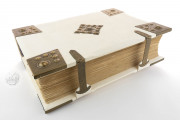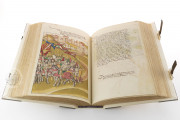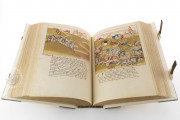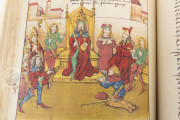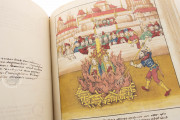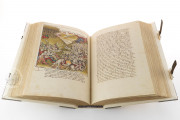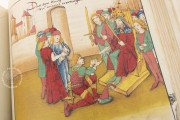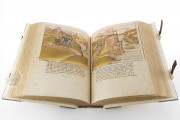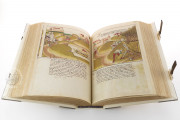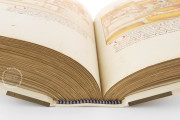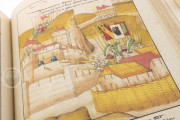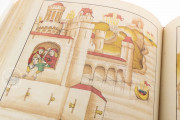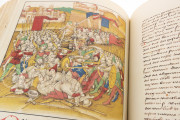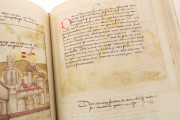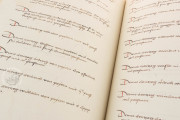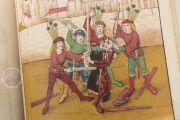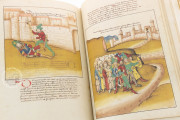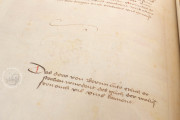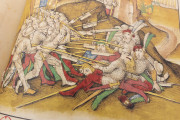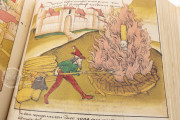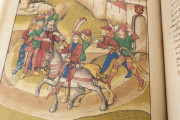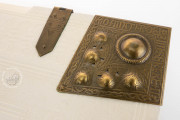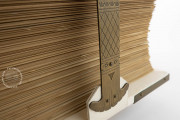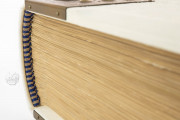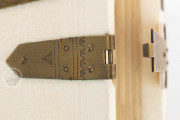The Lucerne Chronicle by Diebold Schilling the Younger, completed in 1513, is a richly illuminated manuscript depicting Swiss life from its origins to the early sixteenth century. The chronicle vividly portrays the political, social, economic, and religious dimensions of the Swiss Confederation in text and 443 vibrant miniatures. Beyond its local significance, it stands as a visual compendium of its time and a vital resource for understanding the culture and complexities of the late medieval world.
The chronicle presents a multifaceted view of late Middle Ages society—political, social, economic, and religious—creating an invaluable resource for historical researchers across disciplines.
Chronicles as Important Works of the 15th and 16th Centuries
Lavishly illuminated chronicles represent significant artistic and historical achievements of the late 15th century. While some were commissioned by nobility, most originated from the rising bourgeoisie in economically thriving urban centers.
This emerging affluence and social confidence manifested not only through impressive secular and religious architecture, but also through the production of chronicles designed to document contemporary events through both imagery and text for future generations.
Among these historical records, the Lucerne Chronicle stands unparalleled due to its extensive portrayal of medieval subjects. Its exceptional value lies in its comprehensive representation of contemporary life, seamlessly integrating illustrations and textual accounts.
Artistic Elements of the Chronicle
The text appears in late medieval bastard script, though clearly subordinate to the generously conceived illustrations rendered in opaque colors. These visual elements are exceptional in quantity, style, and execution.
The manuscript contains an impressive 443 pages adorned with miniatures in various formats—vertical, horizontal, and square—including several double-page illustrations. The artwork features black contour lines filled with vibrant colors, displaying an extraordinary abundance of human figures, architectural elements, and diverse landscape motifs. The visual impact is enhanced by trompe-l'œil frames featuring Gothic wooden profiles, tracery, banderoles, scrollwork, and surrounding inscriptions.
The manuscript chronicles the history of the Swiss Confederation from its origins through 1513, with particular emphasis on events between 1474 and 1513. Topics include mercenary practices and the Confederation's diplomatic relations with major powers, the emperor, and the Empire.
Artistic Attribution
Two distinct artists contributed to the chronicle's decoration. Several illustrations are attributed to Diebold Schilling, characterized by his more naïve yet precise technique and bold color palette. His work clearly reflects the influence of the Gothic style that defined traditional late medieval miniature painting.
The second artist remains unidentified. His illustrations feature lighter colors and demonstrate more practiced brushwork with evident Renaissance influences. In 1577, the manuscript was bound in a pigskin cover featuring tooled decorations in late Renaissance style.
The Principal Artist: Diebold Schilling
Born circa 1460, Diebold Schilling inherited his artistic inclinations from his family. Both his father and his namesake uncle (creator of the renowned Burgundian and Spiez Chronicles) had studied writing at Lauber's prestigious workshop in Hagenau.
His uncle, initially working as a clerk in a position later filled by Diebold Schilling's father, served as the official chronicler for the City Council of Bern. Diebold Schilling the younger pursued canonical law studies in Basel and later Padua.
From 1479, he served as the official notary of Lucerne and prepared for ecclesiastical life. However, his temperament seemed ill-suited for clerical duties, as evidenced by his multiple legal entanglements involving brawls and honor disputes.
Professional Career
In 1497, Schilling was appointed as an interpreter for a Milanese ambassador and subsequently served as an agent for the Duke of Milan. He briefly worked under Emperor Maximilian before transitioning to the Sforza court in Milan.
During this period, he composed the chronicle, presumably commissioned by Lucerne authorities. In 1513, after several years of dedicated work, he formally presented the completed manuscript to the City Council in a ceremonial session.
The chronicle's first illustration appears on folios 132v/133, depicting a View of Sitten on the left and Werdenberg welcoming the landvogt of Lucerne on the right—documenting this significant historical moment. After this presentation, Diebold Schilling vanishes from historical records. The circumstances of his death remain unknown, though historians place it between 1515 and 1522.
We have 1 facsimile edition of the manuscript "Lucerne Chronicle of Diebold Schilling the Younger": Schweizer Bilderchronik des Luzerners Diebold Schilling facsimile edition, published by Faksimile Verlag, 1981
Request Info / Price

